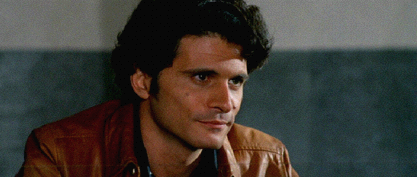Director: Dario Argento
Writers: Dario Argento, Fredric Brown (uncredited for his original novel)
Producer: Salvatore Argento
Cast: Tony Musante, Suzy Kendall, Enrico Maria Salerno, Eva Renzi, Umberto Raho, Renato Romano, Reggie Nalder, Giuseppe Castellano, Mario Adorf, Rosita Torosh, Pino Patti, Gildo Di Marco, Omar Bonaro, Werner Peters, Karen Valenti, Fulvio Mingozzi, Bruno Erba, Carla Mancini, Maria Tedeschi, Annamaria Spogli, Giovanni Di Benedetto
During his stay in Rome, American writer Sam Dalmas (Tony Musante) interrupts an attempted murder of a woman (Eva Renzi) in an art gallery. The police question him and believe the assailant is the serial killer that has murdered three women in the last month. Dalmas thinks there is something he saw during the attack that may be an answer to the mystery. He becomes obsessed with the case and investigates on his own, despite threats from the killer.
The Flashback Fanatic movie review
This film was a very assured effort by the former film critic and screenwriter Argento in the director’s chair for the first time. It has great visual panache and a somewhat cold and off-kilter feel that involve the viewers and keep them on edge. It also has some eccentric character humor that is another technique to keep the audience a bit off balance, even as it amuses. I have seen most of Argento’s films and still consider this one of his best.
The story is a loose interpretation of Fredric Brown’s 1949 novel The Screaming Mimi, which had been adapted into film back in 1958. This film established the basics that Argento gialli would return to: the amateur sleuth with an artistic or literary profession tracking down a demented mystery killer that usually wears black gloves when committing murder; a bizarre clue that is instrumental in finding the killer; an answer to the killer’s identity that only our hero can determine if he can just sort through his skewed or faulty perceptions. In this Argento debut, the police are more helpful to the hero than in some later films where they are sometimes portrayed as ineffectual and even buffoonish.
Argento will probably always be best known for his murder set pieces. The Bird with the Crystal Plumage has one of the most effective in the murder of the killer’s fourth victim (Rosita Torosh). It is not as elaborate and lengthy as many the director would later become famed for, but it still has great impact. A later murder set piece features some uniquely Italian architecture in the stairwells of an apartment house. This reminds me very much of another kill scene from Argento’s Suspiria (1977).
Taking care to establish scenes in interesting and unusual settings makes them memorable. The attack in the art gallery that kicks off the story is a great example of this. The strange and vaguely sinister gray statues arrayed about the cold white expanse of the gallery’s ground floor create a striking image. The only other colors in this chilly tableau are the flesh and blood of the auburn-haired woman struggling with the black silhouette of her attacker. Even the woman’s outfit is white, so that her red hair and blood become a focal point with the black figure she is fighting. All of this occurs in full view of Sam Dalmas helplessly trapped between the sliding glass doors of the gallery entrance. This is the kind of attention to the visual and the practical that makes this scene so memorable.
In later films, the Argento style would become wilder and sometimes overwhelm the story to the detriment of logic and credibility. That extreme always makes me anticipate each new Argento production, yet I feel his style is best served when the script is solid. I appreciate that Argento is pushing himself to approach his work in new ways, though I sometimes wonder if he is simply doing crazy stuff to compensate for a lack of narrative discipline. Perhaps the stylistic extremes in his work are the means for him to maintain his own enthusiasm. Argento has said that he does not like to dwell on his past films and rarely watches them. I assume he is overly familiar with them, but I wish he would review his past triumphs to realize why they worked so well.
We identify most with Tony Musante’s character Sam Dalmas, but only because he is the protagonist trying to uncover the killer. As in many Argento films, we don’t bond with the characters much. They don’t share many feelings or much background with each other and the viewer. This is not very detrimental to this film, since the story is solid and the narrative style is diverting enough to maintain our interest. The quirks and humor of some of the supporting characters also provide a bit of human interest in the film.
Music has always been very important to Argento films. That is certainly the case with Ennio Morricone’s score here. It provides the dissonant and ethereal vibe that unsettles the viewer and compliments the killer’s madness. Morricone would also work on Argento’s next two films and many other gialli with great results.
The Bird with the Crystal Plumage was an incredibly influential film. It not only proved a successful inspiration for giallo films to flourish in Italy, but it also inspired some other European filmmakers to dabble in the genre. There were certainly many American filmmakers benefitting from this influence. The direct descendant of the Italian giallo film would be the American slasher film.
For my part, I now realize that if I ever want to divine the answers to clues that will catch a murdering maniac, I’d better start drinking that J&B Scotch. Excuses, excuses…













No comments:
Post a Comment